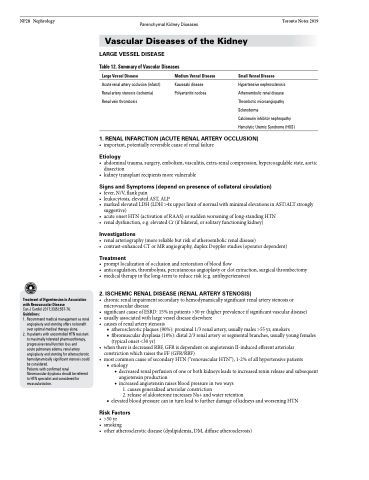Page 728 - TNFlipTest
P. 728
NP28 Nephrology
Parenchymal Kidney Diseases Toronto Notes 2019
Vascular Diseases of the Kidney
LARGE VESSEL DISEASE
Table 12. Summary of Vascular Diseases
Large Vessel Disease
Acute renal artery occlusion (infarct) Renal artery stenosis (ischemia) Renal vein thrombosis
Medium Vessel Disease
Kawasaki disease Polyarteritis nodosa
Small Vessel Disease
Hypertensive nephrosclerosis Atheroembolic renal disease Thrombotic microangiopathy Scleroderma
Calcineurin inhibitor nephropathy Hemolytic Uremic Syndrome (HUS)
Treatment of Hypertension in Association with Renovascular Disease
Can J Cardiol 2017;33(5):557-76. Guidelines:
1. Recommend medical management as renal angioplasty and stenting offers no benefit over optimal medical therapy alone.
2. In patients with uncontrolled HTN resistant to maximally tolerated pharmacotherapy, progressive renal function loss and
acute pulmonary edema, renal artery angioplasty and stenting for atherosclerotic hemodynamically significant stenosis could be considered.
Patients with confirmed renal fibromuscular dysplasia should be referred to HTN specialist and considered for revascularization.
1 . RENAL INFARCTION (ACUTE RENAL ARTERY OCCLUSION)
• important,potentiallyreversiblecauseofrenalfailure
Etiology
• abdominaltrauma,surgery,embolism,vasculitis,extra-renalcompression,hypercoagulablestate,aortic dissection
• kidneytransplantrecipientsmorevulnerable
Signs and Symptoms (depend on presence of collateral circulation)
• fever,N/V,flankpain
• leukocytosis,elevatedAST,ALP
• markedelevatedLDH(LDH>4xupperlimitofnormalwithminimalelevationsinAST/ALTstrongly
suggestive)
• acuteonsetHTN(activationofRAAS)orsuddenworseningoflong-standingHTN • renaldysfunction,e.g.elevatedCr(ifbilateral,orsolitaryfunctioningkidney)
Investigations
• renalarteriography(morereliablebutriskofatheroembolicrenaldisease)
• contrast-enhancedCTorMRangiography,duplexDopplerstudies(operatordependent)
Treatment
• promptlocalizationofocclusionandrestorationofbloodflow
• anticoagulation,thrombolysis,percutaneousangioplastyorclotextraction,surgicalthrombectomy • medicaltherapyinthelong-termtoreducerisk(e.g.antihypertensives)
2 . ISCHEMIC RENAL DISEASE (RENAL ARTERY STENOSIS)
• chronicrenalimpairmentsecondarytohemodynamicallysignificantrenalarterystenosisor microvascular disease
• significantcauseofESRD:15%inpatients>50yr(higherprevalenceifsignificantvasculardisease) • usuallyassociatedwithlargevesseldiseaseelsewhere
• causes of renal artery stenosis
■ atherosclerotic plaques (90%): proximal 1/3 renal artery, usually males >55 yr, smokers
■ fibromuscular dysplasia (10%): distal 2/3 renal artery or segmental branches, usually young females
(typical onset <30 yr)
• whenthereisdecreasedRBF,GFRisdependentonangiotensinII-inducedefferentarteriolar
constriction which raises the FF (GFR/RBF)
• most common cause of secondary HTN (“renovascular HTN”), 1-2% of all hypertensive patients
■ etiology
◆ decreased renal perfusion of one or both kidneys leads to increased renin release and subsequent
angiotensin production
◆ increased angiotensin raises blood pressure in two ways
1. causes generalized arteriolar constriction
2. release of aldosterone increases Na+ and water retention
■ elevated blood pressure can in turn lead to further damage of kidneys and worsening HTN
Risk Factors
• >50yr
• smoking
• otheratheroscleroticdisease(dyslipidemia,DM,diffuseatherosclerosis)


